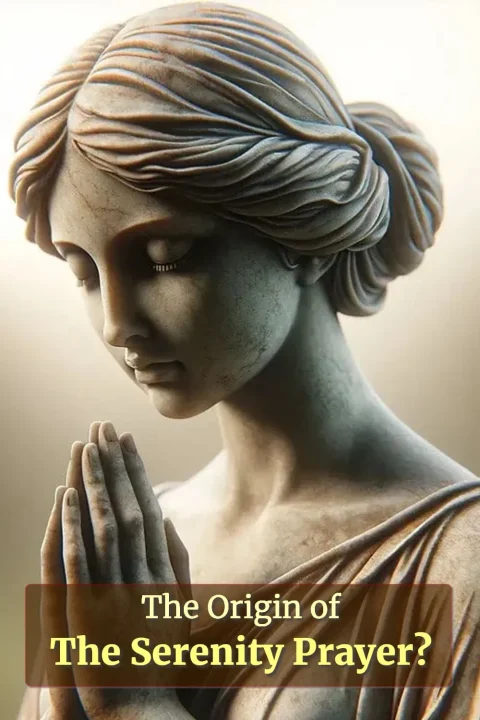• Feb 16, 2024 • Read in ~10 mins
— Researched and written by Dr. Sandip Roy.The Serenity Prayer is widely practiced by people of diverse faiths, cultures, and religious traditions. Even atheists and non-religious people use it to benefit from it.
We often identify the Serenity Prayer with the Alcoholics Anonymous (AA) movement, but it has a much richer and longer history.
And that history contains a controversial origin, hinting that a man’s voice might have silenced a woman’s voice.
The Serenity Prayer
The prayer has undergone slight modifications over the years (Littleton & Bell, Living the Serenity Prayer: True Stories of Acceptance, Courage, and Wisdom, 2008).
The most recent version is as follows:
“God, grant me the serenity to accept the things I cannot change,
the courage to change the things I can,
and the wisdom to know the difference.”

Who wrote the Serenity Prayer, and when?
The Serenity Prayer is widely believed to have been composed by the theologian Reinhold Niebuhr in 1943. However, the first mention of the prayer was found in an entry in the personal diary of Winnifred Crane Wygal, around 1933. Niebuhr may likely have heard it from Wygal while she studied under him, or she may have heard it from him.
The controversy around the origin of the Serenity Prayer is whether it was the far more powerful Niebuhr who had drowned out a woman’s voice.
Most people assume that the Serenity Prayer author was the American theologian and pastor Reinhold Niebuhr. Most citations mention that Niebuhr first used the prayer in a sermon in a rural Massachusetts church, in 1944.
- Niebuhr’s biographer, Charles C. Brown, writes that Niebuhr composed it between 1941 and 1943.
- Niebuhr’s daughter Elisabeth Sifton wrote in her 2003 book The Serenity Prayer: Faith and Politics in Times of Peace and War about her father’s first use of it in 1943 at a church in the Massachusetts town of Heath.
- Whenever Niebuhr was asked about the originality of his contribution during his lifetime, he usually replied, “I honestly do believe that I wrote it myself.”
However, Fred R. Shapiro, associate library director and lecturer at Yale Law School, claims that the Serenity Prayer was written and used much earlier than 1943. He says it was mentioned:
- by the YWCA leader Winnifred Crane Wygal in 1933,
- by the Oklahoma public school counselor Mildred Pinkerton in 1936, and
- by several American civic leaders around those years.
“Since 2003 I have been researching the origins of the prayer, ultimately discovering that its earliest findable use was actually by an obscure woman named Winnifred Wygal, a Y.W.C.A. official who was an associate of Niebuhr’s, with her usage dating as far back as 1933.”
— Fred R. Shapiro in The New Yale Book of Quotations.
In 2017, William FitzGerald of Rutgers University-Camden proposed that the prayer should be duly credited to YWCA official and Neibuhr’s student Winnifred Wygal.
The Serenity Prayer was first published by Niebuhr in his book “The Nature and Destiny of Man,” 1943. Had it appeared in his first book “Leaves from the Notebook of a Tamed Cynic” in 1929, we believe there would have been no controversy.
With his permission, the Serenity Prayer was published in a printed booklet for the United States Army titled Book of Prayers and Services for the Armed Forces, 1944.
Origin of Serenity Prayer
The Serenity Prayer is widely believed to have been written and preached by American theologian Reinhold Niebuhr in the early 1940s.
The prayer quickly gained popularity as it spread through church groups and the army in the United States.
The Alcoholics Anonymous program, and later other 12-step programs, adopted the Serenity Prayer to encourage its members to submit their will to a higher power and find strength and resilience to face their struggles with alcoholism.
Today, it is an international and multicultural practice, with people from various spiritual traditions, as well as secular people, using the prayer to find peace and love in difficult times.
Early versions of the prayer had no title, but by 1955, it started being referred to as the Serenity Prayer in Alcoholics Anonymous publications.

Did the Serenity Prayer originate from Stoicism?
Many scholars feel that the modern Serenity Prayer originates from ancient Stoicism.
There is no proof that Niebuhr was directly influenced by the slave-turned-philosopher Epictetus when he wrote the Serenity Prayer, but ideas from Stoic philosophy may have played a role in shaping his thoughts and beliefs.
There seems to be a consistent overlap between Niebuhr’s interest in social ethics and justice, and Stoicism’s emphasis on reason and personal responsibility.
Also, Niebuhr may read works by other philosophers or religious figures who were influenced by the Stoic tradition.
Glenn Chesnut, Professor Emeritus of Ancient History at Indiana University, says,
By the end of the Greco-Roman period, most philosophers were teaching mixtures of Stoic and Platonic (and sometimes Aristotelian) philosophy. They were called Late Stoics or Middle Platonists or Neo-Pythagorians or other technical terms like that, but all of them had mixed a lot of Stoic ideas into their thought. Even the writings of an Academic Sceptic like Cicero were filled with references to Stoic ideas.
— Glenn Chesnut
And by the second century, Christian theologians were using a mixture of Stoic and Middle Platonic philosophy to explain their own Christian ideas. In the eastern end of the Mediterranean, most early Christian theologians taught that serenity in the Stoic sense was the goal of the Christian life, and Eastern Orthodox Christianity still teaches that to this day.
In a recent book, 365 Ways to Be More Stoic by Tim Kebon Kasey Pierce, the authors say, “…the seeds of the Serenity Prayer can be seen in Epictetus’s Handbook written nearly two thousand years ago.”

The Stoic philosophy, which was developed in ancient Greece and Rome, emphasizes the importance of accepting the things that we cannot change and focusing on the things that we can control.
This emphasis on acceptance and control is similar to the message of the Serenity Prayer, which asks for the serenity to accept the things we cannot change, the courage to change the things we can, and the wisdom to know the difference.
The Benefits of Serenity Prayer Practice
The Serenity Prayer is practiced by people of many different faith traditions, and even atheists, as a way to find peace and acceptance in difficult times.
It warns against the arrogant assumption of mastery (“serenity for what cannot be changed”) and also the excuse for inability (“courage for what can be changed”).
Here are some benefits of practicing the Serenity Prayer:
1. Find inner peace in difficult situations
The Serenity Prayer asks for the serenity to accept what you cannot change, which can be a powerful way to let go of your stresses and worries.
This first part of the prayer is emotion-focused coping, an effective stress management strategy for situations in which external influences cannot be changed (Myers, 2012)
Serenity allows us to live in peace with many things that should but cannot be changed (like grief over a friend moving away).
2. Give you the courage to take action
The Serenity Prayer also asks for the courage to change what you can, which can motivate you to take positive steps in your life in the bold pursuit of your goals.
This second part is an example of problem-focused coping, in which we focus on addressing the stressful situation or resolving the stressor.
Problem-focused coping is an effective stress management strategy when situational influences are within a person’s control and can be changed (Myers, 2012).
3. Develop the wisdom to grit or quit
The Serenity Prayer asks for the wisdom to tell the difference between what you can and cannot change, so that you can make better decisions and stay focused on what is most important.
This final section is an example of perceived control. Perceived control is the process of determining whether a situation is changeable and then deciding whether to use emotion-focused or problem-focused coping techniques.
People choose emotion-focused techniques when they sense a lack of control, and problem-focused strategies when they perceive control.
4. Grow a sense of satisfaction in life
The Serenity Prayer can help you achieve a deeply enriching and fulfilling sense of life satisfaction by focusing on acceptance and calmness during hard times.
5. Get a sense of connection and support
The prayer is used in the Alcoholics Anonymous (AA) program, helping provide a sense of connection and support to people who are struggling with addiction.
Who was Reinhold Niebuhr?
Reinhold Niebuhr (1892-1971) was a pastor and Protestant theologian, and a reformed-pacifist who persuaded Christians to support the war against Hitler.
He was a powerful man, once labeled as “the greatest living political philosopher of America.”
Niebuhr served as pastor of Bethel Evangelical Church in Detroit from 1915 to 1928. Then he taught at Union Theological Seminary in New York City, as a professor of applied Christianity, and became a great intellectual and personal force until his retirement in 1960.
“The only possible peace within and between human communities is the peace of forgiveness. It is not a peace of perfect accord of life with life but a peace which is established beyond the frictions of life.”
– Niebuhr, R., Discerning the Signs, 187-88
He was a founder of the Americans for Democratic Action and he was vice chairman of the Liberal Party in the state of New York.
Some of Niebuhr’s books are:
- Leaves From the Notebook of a Tamed Cynic: Diary of a young minister’s trials (1929)
- Moral Man and Immoral Society (1932)
- The Nature and Destiny of Man, 2 vol. (1941–43)
- Faith and History: A Comparison of Christian and Modern Views of History (1949)
- The Irony of American History (1952)
- The Self and the Dramas of History (1955)
- The Structure of Nations and Empires (1959)
Douglas John Hall, Th.D., tells an anecdote about Niebuhr in the foreword to Remembering Faithfully Forward: The Daily Niebuhr Family Meditation-Contemplation Reader:
Once a person asked, “Dr. Niebuhr, what precisely do you mean by pride?”
Niebuhr remarked, pointing to the artist’s big signature on a painting that hung just behind the lectern, “That’s what I mean.”
Hall thought the artist was in the audience.
FAQs
Did Niebuhr actually write the Serenity Prayer?
The exact origins of the Serenity Prayer are wrapped in mystery. Though Reinhold Niebuhr is credited with writing the original Serenity Prayer, many people doubt that he is the original author.
Fred Shapiro and William FitzGerald claim that it was Winnifred Wygal, a student of Niebuhr, who wrote it first in 1933, as evidenced by her diary.
However, whenever Niebuhr was asked about his originality, he usually replied, “I honestly do believe that I wrote it myself.”
What is the Stoic serenity prayer?
Anyone familiar with Stoic ideology and vocabulary can recognize similarities of the modern serenity prayer to both Stoic ideology and vocabulary.
Courage and wisdom formed two of the four cardinal Stoic virtues, along with self-control and justice.
The Stoic serenity prayer could be this quote by Epictetus:What, then, is to be done? To make the best of what is in our power, and take the rest as it naturally happens. (Discourses, 1.1.17)
While Marcus Aurelius expresses its essence in these words:
“Nature, give what it pleases you to give, and take what it pleases you to take” (Meditations, 10.14).
Final Words
We believe that the Serenity Prayer may have its roots in Stoicism, the ancient Greco-Roman philosophy that started with Zeno, and reached its peak with Epictetus, Seneca, And Marcus Aurelius.
√ Also Read: Did Marcus Aurelius actually say, “Death smiles at us all?”
√ Please spread the word if you found this helpful.
• Our Story!
